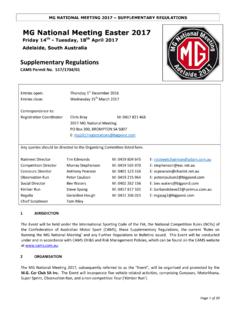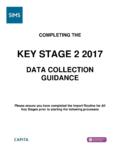Transcription of New CPT Codes for 2017 - evtoday.com
1 VOL. 15, NO. 11 NOVEMBER 2016 ENDOVASCULAR TODAY 43 CPT copyright 2016 American Medical Association. All rights preview of the changes ahead for interventional CPT coding effective January 2017 . BY KATHARINE L. KROL, MD, FSIR, FACRNew CPT Codes for 2017It s time for my annual column on new Codes being introduced for the upcoming year. Several changes will affect practices in 2017 , and this column addresses many of them. There is also a new set of Codes for dialysis access interventions that will not be addressed in this column. If your practice performs those services, you will want to become familiar with that new code set in addition to the Codes discussed in this article.
2 MODERATE SEDATIONT here are important changes to reporting for moder-ate sedation (MS) services. Beginning January 1, 2017 , MS is no longer bundled into any interventional service and may be separately reported when performed and documented. This is particularly important because for services that previously included MS, value has been deducted from the relative value units assigned to each code to reflect that MS is no longer part of that service. If MS is now not separately reported, that value will be lost. This is a small value for work relative value units for each case, but it may add up significantly over the course of a year.
3 In addition, accurate reporting will likely be very important for practice expense value if MS is being provided in a nonfacility setting. The previous Codes for MS will be retired, and there will be six new Codes for MS. In addition, the definitions and rules for reporting MS have been modified. The Centers for Medicare & Medicaid Services has histori-cally not paid for MS separately when it is provided by the physician/qualified health care professional who is also performing the procedure that the MS is sup-porting, in large part due to overlapping time with both services provided by the same person at the same time.
4 It has been reasoned that paying for both would be double dipping or paying for two things at once when a single person can only be doing one thing at a time. However, as a bundled service, payment for MS was sometimes included when MS was not provided. In some areas of medicine, services have evolved, and MS may no longer be part of the most typical service described by that code. For instance, gastrointestinal endoscopy is usually performed with an anesthesiolo-gist to provide deeper sedation, and MS is given in only a small number of gastrointestinal endoscopy procedures.
5 It was therefore determined that MS would be unbundled. CPT has tried to clarify the addi-tional work and service of MS, even when given by the same discussions in the CPT Workgroup for Moderate Sedation, coding questions posed to me, and discussions of MS in other venues during my career, it is clear to me that there is significant variance in how MS is performed across practices. There is also signifi-cant variation in local institutional requirements for reporting MS. In order to be paid appropriately for the service you are providing, it will be very helpful for each provider to understand how your institution and bill-ers define MS and potentially to give input to be sure those definitions include MS as provided in the inter-ventional is defined in CPT, and the MS Codes are con-structed using this definition.
6 It is intended that report-ing of MS for billing should be done using the CPT definitions. Moderate (conscious) sedation is defined in CPT as a drug-induced depression of consciousness. During MS, the patient maintains the ability to pur-posefully respond to verbal commands (either alone or with light tactile stimulation). The patient is able to maintain cardiovascular and airway function with-out support, and spontaneous ventilation is adequate for the patient. CPT also specifies that MS is different than the administration of medications for pain con-trol, minimal sedation (anxiolysis), or deeper sedation requiring monitored anesthesia care.
7 The new MS CODING & REIMBURSEMENT44 ENDOVASCULAR TODAY NOVEMBER 2016 VOL. 15, NO. 11 CODING & REIMBURSEMENT Codes should not be reported for services that do not meet the definition of MS. CPT does not specify the drugs or doses required for reporting MS. Many institutions have local definitions for MS, including specifics on drugs, dosages, or number of drugs used. Therefore, it may be helpful to discuss the MS changes with your coders prior to reporting the new Codes . Educating your coders on how MS is provided and understanding their needs for docu-mentation to support the service you are providing should lead to more successful payments for services.
8 For instance, some practices use an opioid alone for MS, but for compliance purposes, because CPT defines that pain medication given for pain control is not MS, billers may determine that they cannot bill MS when an opioid alone is given. Bidirectional communication and education between providers and billers can help ensure that the correct Codes are reporting remains tied to intraservice time of service with the new Codes , but CPT has uncoupled the time of MS from the time of the procedure. Previously, MS reporting was tied to intraprocedure time and began with skin incision or vessel puncture.
9 In 2017 , this reporting changes so that the reporting time for MS begins with the first dose of sedative medication. The reporting physician must actually order the drug(s) and dosage(s) used throughout the MS and must be face to face with the patient from the time the first dose is given until the end of the MS service. If face-to-face time ends, the time for MS ends, and any addi-tional face-to-face time required later, even if related to MS, is considered postservice work and is not counted as time on which reporting is based. MS is typically started prior to skin incision, requiring time for the drugs to take effect before the procedure starts, so MS time typically begins prior to procedure start time.
10 However, this is not always the case. For instance, if it is anticipated that MS will not be needed for a procedure and the procedure is started without MS, but the patient requires MS at some later point during the case, the intraservice time used for the pur-poses of reporting MS is determined from the time of the first dose of MS drugs, not the time that the proce-dure is also intended that MS is reported only when the physician/qualified health care professional is actually ordering the drugs and is present during the entire case. It is not appropriate to count time when the physician is not present as part of intraservice time for MS.







